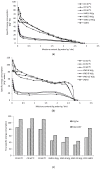Characterisation of the Convective Hot-Air Drying and Vacuum Microwave Drying of Cassia alata: Antioxidant Activity, Essential Oil Volatile Composition and Quality Studies
- PMID: 31022967
- PMCID: PMC6515325
- DOI: 10.3390/molecules24081625
Characterisation of the Convective Hot-Air Drying and Vacuum Microwave Drying of Cassia alata: Antioxidant Activity, Essential Oil Volatile Composition and Quality Studies
Abstract
The preservation of active constituents in Cassia alata through the removal of moisture is crucial in producing a final product with high antioxidant activity. This study aims to determine the influences of various drying methods and drying conditions on the antioxidant activity, volatiles and phytosterols content of C. alata. The drying methods used were convective drying (CD) at 40 °C, 50 °C and 60 °C; freeze drying; vacuum microwave drying (VMD) at 6, 9 and 12 W/g; and two-stage convective pre-drying followed by vacuum microwave finish drying (CPD-VMFD) at 50 °C and 9 W/g. The drying kinetics of C. alata are best described by the thin-layer model (modified Page model). The highest antioxidant activity, TPC and volatile concentration were achieved with CD at 40 °C. GC-MS analysis identified the presence of 51 volatiles, which were mostly present in all samples but with quantitative variation. The dominant volatiles in fresh C. alata are 2-hexenal (60.28 mg 100 g-1 db), 1-hexanol (18.70 mg 100 g-1 db) and salicylic acid (15.05 mg 100 g-1 db). The concentration of phytosterols in fresh sample was 3647.48 mg 100 g-1 db, and the major phytosterols present in fresh and dried samples were β-sitosterol (1162.24 mg 100 g-1 db). CPD-VMFD was effective in ensuring the preservation of higher phytosterol content in comparison with CD at 50 °C. The final recommendation of a suitable drying method to dehydrate C. alata leaves is CD at 40 °C.
Keywords: Cassia alata; antioxidant activity; drying technology; essential oil volatile composition; phytosterol; vacuum microwave.
Conflict of interest statement
The authors declare no conflicts of interest.
Figures



References
-
- Sagnia B., Fedeli D., Casetti R., Montesano C., Falcioni G., Colizzi V. Antioxidant and anti-inflammatory activities of extracts from Cassia alata, Eleusine indica, Eremomastax speciosa, Carica papaya and Polyscias fulva medicinal plants collected in Cameroon. Plos ONE. 2014;9:e103999. doi: 10.1371/journal.pone.0103999. - DOI - PMC - PubMed
-
- Chatterjee S. Cassia alata-An useful antimicrobial agent. Med. Aromat. Plants. 2013;2:e143. doi: 10.4172/2167-0412.1000e143. - DOI
-
- Ross I.A. Medicinal Plants of the World. Volume 1. Springer Science & Business Media; New York, NY, USA: 2003. Cassia alata L. pp. 165–174.
MeSH terms
Substances
Grants and funding
LinkOut - more resources
Full Text Sources
Medical
Miscellaneous

